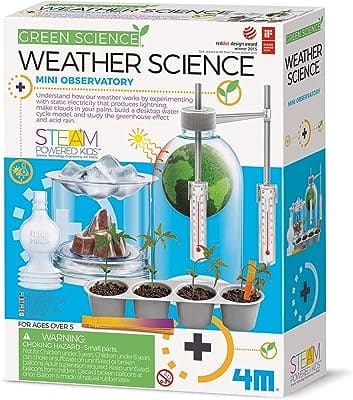Experience the raw forces of nature from the comfort of your own home with the 4M Weather Science Kit ↗. This engaging educational tool brings the complex world of hydrometeorology to life, offering hands-on experiments that demonstrate how weather patterns work and how they can lead to natural disasters like floods.
Dive into the fascinating world of weather and learn about the science behind the headlines. Discover the factors that trigger a flood, grasp the elements of the water cycle, and develop a deeper understanding of our planet’s most powerful and unpredictable phenomena.
Don’t just read about floods – see the science in action. Click here to get your 4M Weather Science Kit on Amazon today ↗ and embark on an extraordinary educational journey.
Introduction
Floods are among the most devastating natural disasters, causing loss of life and property worldwide. Understanding their formation, propagation, and aftermath from a hydrometeorological perspective can help us better predict, prepare for, and mitigate their impacts.
What is Hydrometeorology?
Hydrometeorology is a branch of meteorology that studies the transfer of water and energy between the land surface and the lower atmosphere. It plays a crucial role in understanding weather phenomena, particularly those involving water such as floods.
How are Floods Formed?
Floods occur when an area of land that is usually dry suddenly gets submerged underwater. This can happen due to several reasons, including excessive rainfall, rapid snowmelt, or a blockage in the water flow due to landslides or ice. Hydrometeorological factors such as heavy rain and rapid snowmelt are often significant contributors to flood formation.
Types of Floods
There are various types of floods, and hydrometeorological factors influence each differently:
- Flash Floods: These occur due to heavy or excessive rainfall in a short period, often less than six hours. They can also occur due to dam or levee break.
- Riverine Floods: Caused by overbank flow from rivers, influenced by prolonged rainfall or rapid snowmelt.
- Coastal Floods: These are caused by storm surge, high tides, or tsunamis and are influenced by meteorological factors such as storms and hurricanes.
- Urban Floods: These occur in cities, where the large extent of impervious surfaces prevents natural infiltration of water into the ground.
The Impact of Climate Change on Flooding
Climate change, characterized by increasing global temperatures, is altering the hydrometeorological dynamics of floods. Warmer temperatures enhance evaporation rates, leading to heavier rainfall and potentially more intense floods. According to the Intergovernmental Panel on Climate Change (IPCC), flood risk will increase in many regions due to climate change.
Predicting Floods: The Role of Hydrometeorology
Hydrometeorological data, such as rainfall intensity, snowmelt rate, soil saturation levels, and river flow rates, are crucial in flood prediction. Accurate flood prediction can lead to improved disaster management, reducing loss of life and property. For instance, early warning systems can be developed, allowing people sufficient time to evacuate or take other necessary actions.
Case Study: A Hydrometeorological Analysis of a Recent Flood Event
Take the 2023 floods in Alberta, Canada, for example. Following an unusually warm spring leading to rapid snowmelt coupled with heavy rainfall, the region experienced severe flooding. The hydrometeorological factors at play—rapid snowmelt and heavy rainfall—contributed to the overbank flow from rivers, leading to widespread flooding.
How to Protect Yourself and Your Property From Floods
Understanding floods and their hydrometeorological underpinnings is the first step towards protection. Here are some strategies for flood preparedness:
- Flood Barriers: Portable flood barriers like the Quick Dam Flood Barrier ↗ can be used to block water from entering homes.
- Waterproofing: Waterproof your basements and consider installing a sump pump. The Wayne Submersible Sump Pump ↗ is a reliable option.
- Evacuation Plan: Ensure your family knows the quickest evacuation route from your home.
Conclusion
Understanding floods from a hydrometeorological perspective is crucial in today’s changing climate. Not only does it improve our predictive capabilities, but it also empowers us to take appropriate actions to protect ourselves from their devastating impacts.
Stay safe and remember—knowledge is the first step towards protection!
Other Articles
Thank you for exploring “Understanding Floods: A Hydrometeorological Perspective”. If you found it enlightening, please consider sharing it. You might also be interested in these other articles on Sunny Days Go:
- Predicting Weather: The Role of Hydrometeorology ↗
- The Effects of Climate Change on Weather Patterns ↗
- The Importance of Temperature in Our Changing Climate ↗
- Heat and Its Role in Climate Change: A Deep Dive ↗
- How to Prepare for Extreme Weather Eventsy ↗
Each of these articles provides further insights into our ever-changing climate and weather patterns.

